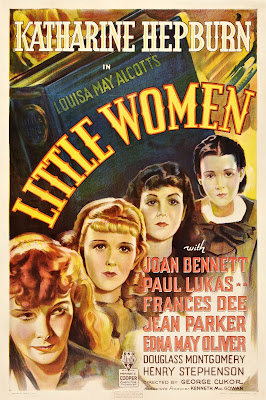With no new films to review for the foreseeable future, Reel Speak’s new feature, Reel Retro Reviews, will randomly review a classic film from the TCM broadcast schedule every Monday. Not just for the sake of filling time, but to hopefully introduce some classic, overlooked, and perhaps forgotten screen gems to those of us who may be unfamiliar or unawares of their existence.
Louisa May Alcott’s classic novel Little Women has been adapted to the big screen seven times, with the most recent being Greta Gerwig’s 2019 Oscar-nominated version. Gerwig’s take immediately drew discussions on which adaptation has been the best, and since most filmgoers have short memories, the 1994 version was the first to be recalled. But often overlooked is the 1933 LITTLE WOMEN, which was the third rendition, the first with sound, and starred future Hollywood legend Katharine Hepburn.
Set during and after the American Civil War, the March sisters; Jo (Hepburn), Amy (Joan Bennett, Meg (Frances Dee), and Beth (Jean Parker)…await the return of their father from the war with their mother Marmee (Spring Byington), and Aunt March (Edna May Oliver). While they wait, the girls deal with love, loss, and their futures.
Directed by George Cukor and written for the screen by the husband-and-wife team of Sarah Y. Mason and Victor Heerman, LITTLE WOMEN is constructed of a series of vignettes focusing on the struggles of the March family, as each one of the sisters grapple with war, family, and personal responsibility. The sisters, whose personalities range from tomboy to oversensitive, drive the story with their distinctive characteristics on display at all times. The film is quite faithful to the novel, and for 1933 a step forward for women in film; they handle their problems on their own without the presence of men.
Director George Cukor puts an earnestness into the story that works. There is a lot of heart which makes for some emotional gut-punches; a scene where the March family helps a needy family, and the eventual passing of a character are definite tear-jerkers. The characters and story are very much relatable with their personalities and obstacles to overcome matching what any one of us would have to deal with today. It’s a story of moral choices, and relationships with one another, and its simple execution makes it lovable.
Acting is wonderful with Katharine Hepburn being the expected dominant force. LITTLE WOMEN was only her fourth film (and her first after winning her first Oscar), but the greatness can be seen this early. The rest of the cast is excellent, with Joan Bennett a standout.
Gerwig’s 2019 version takes a lot of cues from this 1993 film, with many shots replicated and even settings re-constructed. It wasn’t a carbon-copy as much as a homage…a homage that this version certainly deserves. Its endearing messages of thankfulness and family are as relevant today as they were nearly 100 years ago, and makes for a lovely film experience.
BOTTOM LINE: See it
*
Reel Facts: LITTLE WOMEN was nominated for three Oscars, including Best Picture, and would win for Best Adapted Screenplay. The film was a box office success and would finish as the fourth highest-earner of the year.








